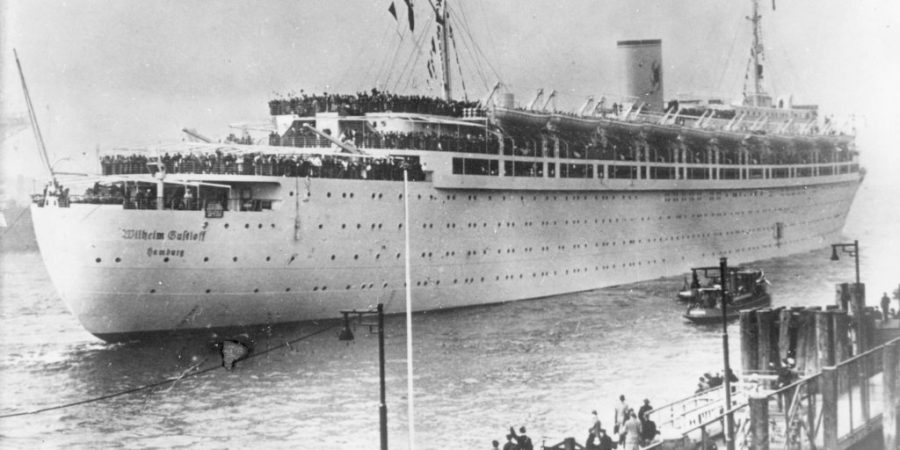9,000+ Lives Lost at Sea: The Sinking of the Wilhlem Gustloff
ullstein bild via Getty Images
The Wilhelm Gustloff 1945
April 7, 2021
It’s the biggest maritime disaster of all time and frankly, nobody knows about it. On January 30, 1945, a previously extravagant German cruise liner carried military personnel and equipment along with thousands of refugees in Operation Hannibal, the last resort for the Nazis to continue in the war. While navigating the dangerous Baltic Sea, the captains of the Gustloff made many questionable decisions that were favorable for the Soviet S-13 captain, Alexander Marinesko, who relied on a huge attack to redeem his tarnished reputation. Compared to the Titanic which sunk in 1912, this story has received significantly less awareness although its death sentence was 6 times greater!
It was 1945, and the Nazis were trying to regain strength to make a comeback in the war. Millions of refugees from East Prussia were fleeing from the Red Army that was quickly advancing. The Nazis realized they could not fight them back and decided to escape to Poland. The Nazi’s plan was a massive exodus which makes the British Dunkirk evacuation seem obsolete. Originally, the soldiers handed out tickets to the thousands of refugees seeking safety. It got so overwhelming that they stopped counting and witnesses say the refugee count was upwards of 9,000+ people. In perspective, this ship was designed to carry 1,900 passengers!
On January 30, the Wilhelm Gustloff left the port with military equipment and refugees crammed in every corner. Captain Peterson and Captain Zahn had difficulties from the start. They had to decide between two less favorable options. Either they took the shallow waters filled with enemy mines or risked the deep waters which lurked with Soviet submarines. Neither option was ideal, but they decided on Emergency Route 58, the deepwater route, which would get them to Kiel, Poland faster.
The first mistake made by the captains happened soon after departing. They proceeded without a convoy of protection. Since the other boats had technical difficulties, rather than waiting, they left defenseless. Secondly, Captain Peterson argued the Gustloff should voyage at no more than 12 knots an hour ( 14 MPH). Although the ship could go 15 knots per hour (17 MPH), Peterson worried since the ship had been utilized as barracks for a majority of the war, the high speeds would be too much pressure for the engines. Although submarines could only go 2-4 knots per hour (3-5 MPH), this made it easier for S-13 to chase them down. The biggest mistake made that night was to turn on the ship’s lights. It was the middle of the night and there was little visibility. Reports of German minesweepers were floating around, so to prevent collisions, the captains turned on the ship’s lights. This made them an easy, glowing, target.
This target was spotted by a veteran Soviet captain, Alexander Marinesko. He desperately needed an attack to fix his tarnished reputation. After being caught by the NKVD “fraternizing with a foreigner” (Prince 127), which was strictly against Soviet policies, he was faced with losing his military security and possibly execution. So when they saw this 684-foot ship illuminated in the distance, it was the perfect opportunity. Marinesko used his years of experience and impulsive nature for this daring attack. He was able to maneuver the submarine between the Gustloff and the coast, an aim not anticipated by the Germans. At 9 pm, the S-13 released 3 torpedoes which hit the “bow, stern, and amidship.”(WWII Museum)
In less than one hour, the Gustloff completely submerged in the Baltic. Out of the estimated 9,000+ passengers, only 1,239 passengers survived. There is no debate that this is the biggest maritime disaster and a hidden tragedy in WWII. Historians still argue over this lasting question, was this a planned attack, and should be charged as a war crime or a product of the raging war in Europe?
Resources for further information:
Death in the Baltic: The World War II Sinking of the Wilhelm Gustloff by Cathryn J. Prince








Jane Blake • Apr 9, 2021 at 3:45 pm
Well done Julia. A very sad WWII story that has not often been untold.
Paul McEnroe • Apr 7, 2021 at 11:20 pm
I have a fair knowledge of the history of WWII, but had never heard this sad tale- all the people perished at the bottom of the sea. Likely, considering all the death and destruction inflicted by Germany, there is little sympathy for the suffering of German civilians. The writer truly brought the story alive, considered all the circumstances, and raised interesting questions at the end- bravo, Miss Blake.
Jake Blake • Apr 7, 2021 at 9:22 pm
I ws not familiaar with the sinking of the William Gustloff.i found it to be one of the sadder stories that I have read about WW II. Jake Blake
Eileen Blake • Apr 7, 2021 at 9:10 pm
I had never heard the Story and was quite surprised. It was something very unusual in that they were aloud so many people and yet I never heard of it.
Kieran Blake • Apr 7, 2021 at 8:50 pm
Great job Julia!